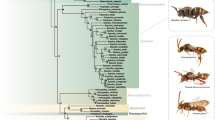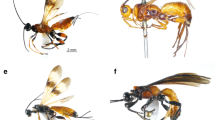Abstract
The high alpine European bumble bee Bombus (Thoracobombus) inexspectatus is one of three taxa in which obligate social parasitism has evolved in bumble bees. Until now, the phylogenetic placement of this species has not been analyzed quantitatively because it is rare in nature. Here a specimen of B. inexspectatus is sequenced for five genes to assess its phylogenetic position relative to other bumble bee species. Phylogenetic estimation of B. inexspectatus places this species within the subgenus Thoracobombus, as expected based on morphology. This provides strong support for the acquisition of social parasitism in B. inexspectatus separate from that found in the bumble bees of the subgenus Psithyrus and B. (Alpinobombus) hyperboreus. Furthermore, B. inexspectatus is not the sister taxon of its host but is a near relative, suggesting a loose but not strict adherence to Emery’s rule. B. inexspectatus is a sister taxon to a clade including B. veteranus, a frequent nest usurper that has been suggested to be a facultative social parasite. The phylogenetic placement of all bumble bee social parasites relative to their hosts is discussed.


Similar content being viewed by others
References
Berezin M.V. 1994. Social organization of the bumblebees (Hymenoptera, Apidae, Bombus) in the Arctic (Wrangel Island). In: Les Insectes Sociaux (Lenoir A., Arnold G. and Lepage M., Eds). Univ. Paris Nord, Paris, pp 320
Bergwall H.E. 1970. Ekologiska iakttagelser over nagra humlearter (Bombus Latr.) vid Staloluokta inom Padjelanta nationalpark, Lule lappmark. Entomol. Tidskr. 91: 3-23
Cameron S.A., Hines H.M. and Williams P.H. 2007. A comprehensive phylogeny of the bumble bees (Bombus). Biol. J. Linn. Soc. 91: 161-188
Choudhary M., Strassmann J.E., Queller D.C., Turillazzi S. and Cervo R. 1994. Social parasites in polistine wasps are monophyletic: implications for sympatric speciation. Proc. R. Soc. B Biol. Sci. 257: 31-35
Emery C. 1909. Über den Ursprung der dulotischen, parasitischen und myrmekophilen Ameisen. Biol. Zbl. 29: 352-362
Hölldobler B. and Wilson E.O. 1990. The Ants. Harvard University Press, Cambridge, Massachusetts, 732 pp
Hines H.M. 2008. Historical biogeography, divergence times, and diversification patterns of bumble bees (Hymenoptera: Apidae: Bombus). Syst. Biol. 57: 58-75
Huang M.H. and Dornhaus A. 2008. A meta-analysis of ant social parasitism: host characteristics of different parasitism types and a test of Emery’s rule. Ecol. Entomol. 33: 589-596
Le Masne G. 1956. Recherches sur les fourmis parasites: Plagiolepis grassei et l’évolution des Plagiolepis parasites. C. R. Acad. Sci. Paris 243: 673-675
Milliron H.E. and Oliver D.R. 1966. Bumblebees from Northern Ellesmere Island, with observations on usurpation by Megabombus hyperboreus (Schönh.) (Hymenoptera: Apidae). Can. Entomol. 98: 207-213
Müller A. 2006. A scientific note on Bombus inexspectatus (Tkalců, 1963): evidence for a social parasitic mode of life. Apidologie 37: 408-409
Pape T. 1983. Observations on nests of Bombus polaris Curtis usurped by B. hyperboreus Schöherr in Greenland. Entomol. Medd. 50: 145-150
Posada D. and Crandall K.A. 1998. Modeltest: testing the model of DNA substitution. Bioinformatics 1: 817-818
Rambaut A. and Drummond A.J. 2007. Tracer v1.4, Available from http://beast.bio.ed.ac.uk/Tracer
Richards K.W. 1973. Biology of Bombus polaris Curtis and B. hyperboreus Schönherr at Lake Hazen, Northwest Territories. Quaest. Entomol. 9: 115-157
Richards K.W. 1975. Population ecology of bumblebees in southern Alberta. Dissertation thesis, University of Kansas, Lawrence, 117 pp
Ronquist F. and Huelsenbeck J.P. 2003. MrBayes 3: Bayesian phylogenetic inference under mixed models. Bioinformatics 19: 1572-1574
Sakagami S.F. 1976. Specific differences in the bionomic characters of bumble bees. A comparative review. J. Fac. Sci. Hokkaido U. (Zool.) 20: 390-447
Sakagami S.F. and Nishijima Y. 1973. Two heterospecific colonies found in Japanese bumblebees, Bombus schrencki and B. pseudobaicalensis (Hymenoptera: Apidae). Res. Bull. Obihiro Zootech. U. Series I 7: 628-631
Savolainen R. and Vepsäläinen K. 2003. Sympatric speciation through intraspecific social parasitism. Proc. Natl. Acad. Sci. USA 100: 7169-7174
Smith J.A., Tierney S.M., Park Y.C., Fuller S. and Schwarz M.P. 2007. Origins of social parasitism: the importance of divergence ages in phylogenetic studies. Mol. Phylogen. Evol. 43: 1131-1137
Stenström M. and Bergmann P. 1998. Bumblebees at an alpine site in northern Sweden: temporal development, population size, and plant utilization. Ecography 21: 306-316
Sumner S., Aanen D.K. and Boomsma J.J. 2004. The evolution of social parasitism in Acromyrmex leaf-cutting ants: a test of Emery’s rule. Insect. Soc. 51: 37-42
Swofford D.L. 2003. PAUP*. Phylogenetic Analysis Using Parsimony (*and Other Methods). Version 4. Sinauer Associaties, Sunderland, Massachusetts
Tkalců B. 1963. Eine neue Hummel-Art der Gattung Agrobombus Vogt aus dem Alpengebiet (Hymenoptera, Apoidea). Časopis Českoslov. Spol. Entomol. 60: 183-196
Voveikov G.S. 1953. Estestvennaya smena samok vo cem’ya shmelej. (Hym., Bomb.). Entomol. Obozr. 33: 174-184
Ward P.S. 1989. Genetic and social changes associated with ant speciation. In: The Genetics of Social Evolution (Breed M.D. and Page R.E., Eds). Westview Press, Boulder, Colorado, pp 123-148
Ward P.S. 1996. A new workerless social parasite in the ant genus Pseudomyrmex (Hymenoptera: Formicidae), with a discussion of the origin of social parasitism in ants. Syst. Entomol. 21: 253-263
Williams P.H. 1998. An annotated checklist of bumble bees with an analysis of patterns of description (Hymenoptera: Apidae, Bombini). Bull. Br. Mus. Nat. Hist. (Ent.) 67: 79-152
Williams P.H. 2008. Do the parasitic Psithyrus resemble their host bumblebees in colour pattern? Apidologie 39: 637-649
Williams P.H., Cameron S.A., Hines H.M., Cederberg B. and Rasmont P. 2008. A simplified subgeneric classification of the bumble bees (genus Bombus). Apidologie 39: 46-74
Yarrow I.H.H. 1970. Is Bombus inexspectatus (Tkalcu) a workerless obligate parasite? (Hym. Apidae). Insect. Soc. 2: 95-112
Acknowledgments
Thanks to Maurizio Cornalba, Pierre Rasmont, Gilles Mahé, and Paul Williams for providing and orchestrating collection of B. inexspectatus specimens. Further thanks to Pierre Rasmont for scientific discussion and comments on the manuscript. This research was funded by USDA grants to SAC (NRI CSREES 2002-35302-11553 and NRI CSREES 2004-35302-15077).
Author information
Authors and Affiliations
Corresponding author
Rights and permissions
About this article
Cite this article
Hines, H.M., Cameron, S.A. The phylogenetic position of the bumble bee inquiline Bombus inexspectatus and implications for the evolution of social parasitism. Insect. Soc. 57, 379–383 (2010). https://doi.org/10.1007/s00040-010-0094-1
Received:
Revised:
Accepted:
Published:
Issue Date:
DOI: https://doi.org/10.1007/s00040-010-0094-1




